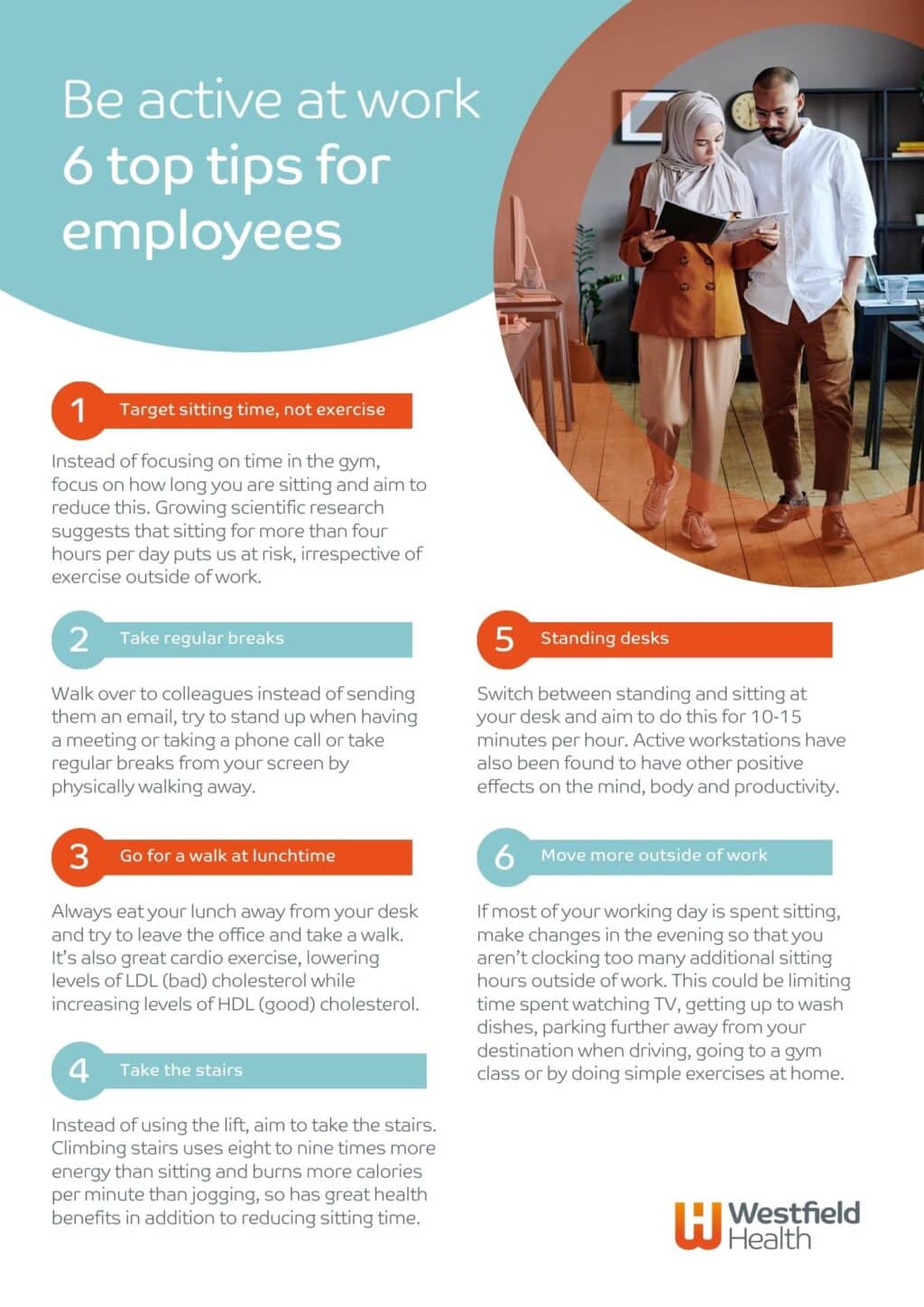Our most recent Wellbeing Index report revealed that people in the UK are at risk of developing chronic diseases due to the amount of time we spend sitting each day and the failure to achieve the NHS’ recommended daily exercise levels. Small changes to be active at work can make a big difference.
Our research revealed that most people (54%) know the NHS guidelines and are aware of the risks of a sedentary lifestyle. However, just 16% manage to achieve the 150 minutes of exercise per week and only 12% are proactively taking steps to reduce sedentary time.
In this article we explore the definition of a sedentary lifestyle, the associated health risks, and the solutions to prolonged inactivity for both individuals and employers.
What is a sedentary lifestyle?
Sedentary behaviour is defined by taking part in little to no physical activity. A sedentary lifestyle consists of excessive periods of sitting or lying down whilst engaging in activities such as reading, watching television or using a mobile phone or computer.
We live in a society where prolonged inactivity is increasingly common. Many of us have desk-based office jobs where we sit down for our daily commutes, and leisure time is often spent sat on the sofa.
Our research puts the average sitting time at just over seven hours a day, but there are other studies which estimate this could be as high as nine hours. The majority of these hours spent seated are in the workplace, and research indicates that this poses a real health risk irrespective of how active people are outside of work.
What are the risks of a sedentary lifestyle?
Leading a sedentary lifestyle is detrimental to our health because it can lead to numerous chronic diseases. In the UK, prolonged inactivity is responsible for one in six deaths.
We need to remember to move at regular intervals to combat the negative effects of prolonged inactivity, which include:
- Burning fewer calories, which makes us more likely to gain weight
- Changes to metabolism, where our bodies may struggle to break down sugars and fats
- A lowered immune system, making us more susceptible to illness
- The weakening of bones, which may lead to osteoporosis
- Loss of muscle strength and flexibility due to not regularly using our muscles
Other potential health risks include:
- Changes in mood, such as depression and anxiety
- Increased risk of certain cancers
- Spikes in blood sugar potentially leading to diabetes
- Musculoskeletal issues such as lower back problems
- Heart diseases including coronary artery disease and heart attack
What are the effects of sitting for too long in the workplace?
Desk-based office jobs contribute heavily towards a sedentary lifestyle. People sit at their desks for hours, then sit in their car, sit down for dinner and finally unwind on the sofa.
Sitting at a desk for long periods of time, combined with environmental factors such as artificial light, and workplace stressors such as meeting deadlines can have a series of negative effects on employee physical and mental wellbeing.
Employees may also struggle to find time to exercise on a daily basis — our Wellbeing Index found that 32% of people find a lack of time to be their biggest barrier to exercise.
This lack of activity has been found to have an adverse effect on productivity, which can add to existing stress, creating a vicious cycle of negative effects — 31% of people say low energy levels prevent them from exercising more, followed by a fifth (21%) stating low mood.
These negative effects on physical and mental health can lead to other issues such as presenteeism and absenteeism, which can result in rising costs to businesses in the long term.
Employees themselves are calling out for support: 67% believe it’s an employer’s responsibility to support their physical wellbeing. This means it’s important for employers to actively seek ways to improve employee health and wellbeing, which includes addressing the effects of a sedentary lifestyle.
The solution to a sedentary lifestyle
Exercise alone isn’t enough to combat the adverse health effects of a sedentary lifestyle. Studies have shown that despite regular exercise we’re still at risk if we sit for more than 6 hours a day. That said, our Wellbeing Index found that over a quarter (26%) of Brits spend nine or more hours sat down per day, with 65% saying they quite or very often sit continuously for one hour or more.
Employers can their employees by offering education on the effects of sitting for long periods, and provide them with resources to help them be more active. A ‘movement mindset’ needs to become part of the workplace culture, with those at the top setting an example for all employees.
A movement mindset isn’t about exercising – it’s about acknowledging that smaller, more frequent bouts of activity are beneficial to our health and taking steps towards moving more. In return, this seemingly small change can have huge health benefits.
Workplace health and wellbeing programmes to address employee health
Our most recent Wellbeing Index found that 84% of people in the UK are failing to achieve the amount of physical activity recommended by the NHS, and workers are calling out for support from their employers. HR professionals also recognise the benefits of investment: 74% agree that physical activity reduces absenteeism.
Reducing sedentary behaviour is just one part of a successful workplace health and wellbeing strategy. Our free Health & Wellbeing Toolkit contains all the information you need to start creating your company’s strategy, featuring help and advice on everything from building the business case and exploring supplier options, to implementing and evaluating the process.
Our free resource outlines six tips for employees to discover ways to be more active at work and improve overall health and wellbeing:
